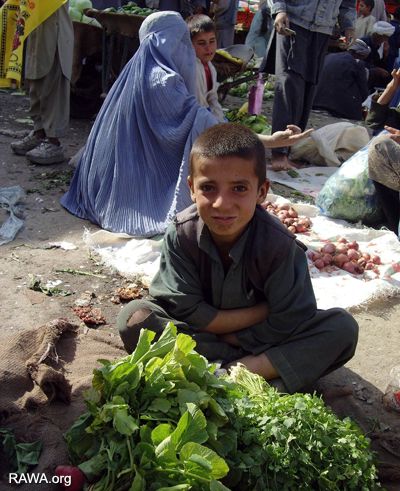IRIN News, April 17, 2008
70% of Afghans - about 18 million people - suffer from acute food insecurity
Afghanistan has a lot of potential to easily become food-secure, even food self-sufficient, owing to its rich soil and plenty of rivers.
KABUL - Afghanistan would have great potential to ensure food security for its estimated 26.6 million people if donors invested in agricultural infrastructure and/or if the country's over 190,000 hectares of poppy were converted to wheat production, a senior official of the UN Food and Agriculture Organization (FAO) said.

Up to 18 million people in Afghanistan live on less than US$2 a day and are considered food-insecure, FAO says
"Afghanistan has a lot of potential to easily become food-secure, even food self-sufficient, owing to its rich soil and plenty of rivers," Tekeste Ghebray Tekie, the FAO country representative, told IRIN in Kabul. Tekeste said rebuilding and developing the country's shattered agricultural infrastructure, particularly the irrigation system, was a prerequisite for food security.
"The impression one gets from outside is that Afghanistan is a mountainous, hilly country, that it does not grow any crops, but if you go to the west of the country, the south, north and northeast it's a food basket, it could even export food," Tekeste said.
Up to 70 percent of Afghans - about 18 million people - suffer from acute food insecurity due to poverty, drought and years of conflict, according to FAO and other aid agencies.
Meanwhile, over two and half million already vulnerable Afghans have been pushed into "high risk" food-insecurity due to a dramatic increase in staple food prices, particularly wheat flour, UN agencies reported.
Investment in irrigation
Before the Soviet invasion in 1979, Afghanistan had 2.5 million hectares of irrigated land which has now dwindled to about 1.5 million hectares, mainly due to destruction caused by years of war.
While Afghanistan's cereal production, chiefly wheat, more than doubled in 2007 compared to 2001 - about 4.6 million tonnes - proper investment in the country's irrigation capacity would lead to another doubling of agricultural output. This would be more than the landlocked nation's requirements.
However, in the post-Taliban rebuilding and development drive agriculture has received only modest donor funding, experts say.
Though the main source of livelihood for about 70 percent of the population, agriculture has received only about US$300 million out of the $15 billion in international aid money spent in Afghanistan over the past six years, Oxfam International reported.
What aid money was spent on agriculture went on "short-term measures" which do not have "sustainable" effects, several American experts said in a report released in January by the Centre for Technology and National Security Policy at the US National Defence University.
Agriculture has received only about US$300 million out of the $15 billion in international aid money spent in Afghanistan over the past six years, Oxfam International reported.
Tempted to switch to wheat?
Afghanistan produces over 90 percent of the world’s opium, according to the UN Office on Drugs and Crime (UNODC). Opium poppy is cultivated on about 193,000 hectares, and over 8,200 tonnes of raw opium will be produced in 2008, UNODC estimated in February.
While UNODC says poppy cultivation in Afghanistan is mostly driven by "greed", a leading US expert, Barnett Rubin of New York University, believes many poor Afghan farmers turn to poppy due to extreme poverty.
Whatever the motives for poppy cultivation, some experts, such as Nasrullah Abid of the Ministry of Agriculture and Irrigation, say rising food prices may tempt some Afghan farmers to cultivate wheat instead of poppy.
According to FAO, the price per tonne of wheat has gone up from $157 in January 2007 to about $500 in April 2008.
"Given the illicit nature of opium poppy and also the government's counter-narcotics efforts, some farmers will consider wheat a lucrative alternative crop," said Abid.
"If you plant wheat in this area [poppy fields] - and if this is under irrigation - you'll get 2.6 tones per hectare, so automatically you're looking at over 400,000 tonnes of additional wheat. If you use this land for high cash crops like vegetables, fruit or cotton, then the contribution to food-security will be enormous," FAO’s Tekeste said.
Characters Count: 5337
